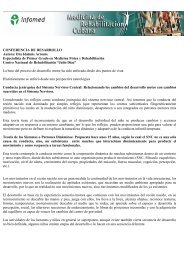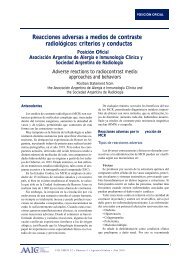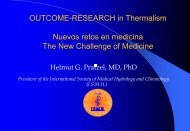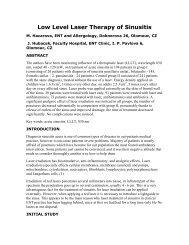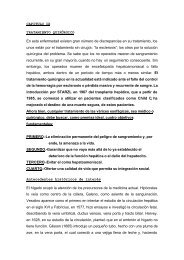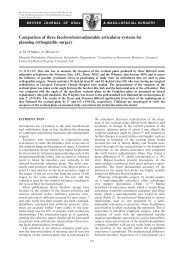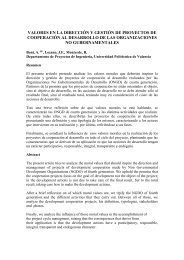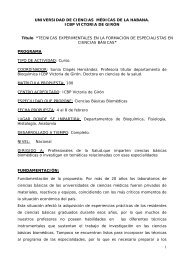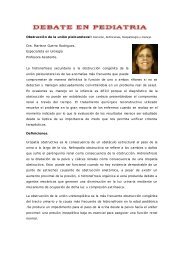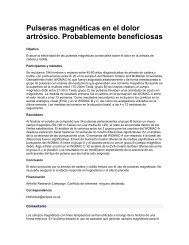pharmacology of medicinal plants and natural products
pharmacology of medicinal plants and natural products
pharmacology of medicinal plants and natural products
Create successful ePaper yourself
Turn your PDF publications into a flip-book with our unique Google optimized e-Paper software.
S106<br />
S. A. DAHANUKAR et al.,<br />
temperature. Solvent extraction, chromatography <strong>and</strong><br />
hydrolysis procedures progressively yielded 3-0-β-<br />
D-glucopyranoso-a-spinasterol. Further studies will<br />
have to be carried out to correlate these principles<br />
with the pharmacological (hypoglycaemic <strong>and</strong><br />
ulceroprotective) activities <strong>of</strong> the plant 251 .<br />
20.8. Phytolectins<br />
Lectins are structurally diverse, carbohydrate binding<br />
proteins that bind reversibly to specific mono-or<br />
oligosaccharides. They are being used by the biomedical<br />
scientists <strong>and</strong> biochemists in blood typing<br />
<strong>and</strong> stimulation <strong>of</strong> cell for chromosome analysis <strong>and</strong><br />
gene mapping, in cell separation, identification <strong>of</strong><br />
complex glycoproteins <strong>and</strong> typing bacteria. Cell targeting<br />
by lectins in cancer therapy is still in its infancy.<br />
Sengupta et al, 252 have reviewed the potential<br />
<strong>of</strong> these biomolecules in medicine.<br />
Lectin activities in roots, nodules, stems <strong>and</strong> leaves<br />
<strong>of</strong> 1-6 week old peanut plant (A.hypogaea) were<br />
checked by erythrocyte (human <strong>and</strong> rabbit) agglutination<br />
<strong>and</strong> sugar inhibition assays. Human <strong>and</strong> rabbit<br />
erythrocyte agglutinating activities were specifically<br />
inhibited by lactose/cellobiose (SLII) <strong>and</strong> methyl<br />
alpha-mannoside (SLI) respectively. Seed embryos<br />
<strong>and</strong> cotyledons agglutinated neuraminidase<br />
treated human erythrocytes <strong>and</strong> that activity was inhibited<br />
by T-disaccharide. In the roots <strong>of</strong> field grown<br />
<strong>plants</strong> SLI was the major activity, while nodules<br />
showed both activities (SLI <strong>and</strong> SLII). Specific activities<br />
<strong>of</strong> SLI <strong>and</strong> SLII were maximal in stem tissue<br />
<strong>and</strong> minimal hypocotyl. Actively growing tissues contained<br />
more SLII activity in comparison to the mature<br />
tissues. Immunological tests indicated that all<br />
the vegetative tissue lectins are serologically related<br />
253 .<br />
21. Miscellaneous<br />
21.1. Reviews on <strong>medicinal</strong> <strong>plants</strong><br />
It is beyond the scope <strong>of</strong> this chapter to justify review<br />
articles that have been published in the last 5 years.<br />
For the benefit <strong>of</strong> the readers, the articles are summarised<br />
in the following paragraphs. An interested<br />
reader may refer to them for detailed information.<br />
Suresh, et al, 254 have investigated the phytochemical<br />
<strong>and</strong> pharmacological activities <strong>of</strong> 25 <strong>medicinal</strong><br />
<strong>plants</strong>, commonly used by the tribals <strong>of</strong> Nilgiris, using<br />
various experimental models viz., CNS-active<br />
<strong>plants</strong> (Araucaria bidwilli, Brachylepsis nervosa),<br />
<strong>plants</strong> with analgesic activity (Araucaria bidwilli,<br />
Brynopsis lacinosa, Cyclea peltata, Ipomoea obscura,<br />
Mirabilis jalappa, Santolina chamaeccyparissus,<br />
Stephania japonica), anti-inflammatory<br />
<strong>plants</strong> (A. houstanianum, Araucana bidwilli, Bauhinia<br />
variegate, Iberis amara, Ipomoea obscura, Mirabilis<br />
jalappa, Santolina chamoeccyparissus,Stephania<br />
japonica, Thunbergia fragrans), antipyretic <strong>plants</strong><br />
(Araucaria bidwilli, Malvastrum corom<strong>and</strong>elianum,<br />
Rumex nepalensis, Santolena chamaeccyparissus,<br />
Stephamia japonicum, Toddalia asiatica), <strong>plants</strong> with<br />
local anaesthetic activity (Mirabilis jalappa), <strong>plants</strong><br />
affecting smooth muscle (relaxant effect) (Araucaria<br />
bidwilli, Bauhinia variegata, Brachylepsis nervosa,<br />
Calotropis gigantea, Cardiospermum helicacabum,<br />
Impomea obscura, Malvastrum corom<strong>and</strong>elianum,<br />
Melianthus major, Rubia cordifolia, Stephania<br />
japonica, Thunbergia fragrans), chemotherapeutic<br />
agents (Brachylepsis nervosa, Calotropis gigantea,<br />
Ipomoea obscura), <strong>plants</strong> modulating fertility (Ailanthus<br />
excelsea), CVS active <strong>plants</strong> (Cystisus scoparius,<br />
Cystisus scoparius), diuretic <strong>plants</strong> (Cystisus<br />
scoparius, Sida cordifolia, Toddalia asiatica),<br />
ulceroprotectives (Araucaria bidwilli, Malvastrum<br />
corom<strong>and</strong>elianum, Santolina chamaeccyparissus),<br />
anti-diarrhoeal <strong>plants</strong> (Bauhinia variegata, Ipomoea<br />
obscura, Malothria perpusilla, Thunbergia fragrans),<br />
haemostatic <strong>plants</strong> (A houstanianum, Toddalia<br />
asiatica) <strong>and</strong> effect on biochemical parameters<br />
(Amarantus spinosus).<br />
Bh<strong>and</strong>ary, et al, 255 conducted ethnomedical field<br />
study on 98 <strong>medicinal</strong> preparations, involving 69 species<br />
<strong>of</strong> <strong>plants</strong>, used by the Siddis <strong>of</strong> Uttara Kannada<br />
in the state <strong>of</strong> Karnataka. Their findings include 40<br />
hitherto unknown <strong>medicinal</strong> uses <strong>of</strong> known <strong>medicinal</strong><br />
<strong>plants</strong>. Among these, the use <strong>of</strong> the stem sap <strong>of</strong><br />
Calamus thwaitesii as an antifertility drug, <strong>and</strong> the<br />
use <strong>of</strong> the flowers <strong>of</strong> Ichnocarpus frutescens <strong>and</strong> the<br />
rhizome <strong>of</strong> Hedychium coronarium in the treatment<br />
<strong>of</strong> diabetes are noteworthy. Aswal et al, 256 have described<br />
the results <strong>of</strong> their scientific endeavours in<br />
which the alcoholic extracts <strong>of</strong> 266 botanically identified<br />
plant materials from 222 plant species were<br />
tested for various biological activities including<br />
chemotherapeutic <strong>and</strong> pharmacological. Eighty-nine<br />
extracts were shown to possess biological activity.<br />
Follow-up studies have been carried out on some <strong>of</strong><br />
these <strong>plants</strong> with confirmed activity. The active




